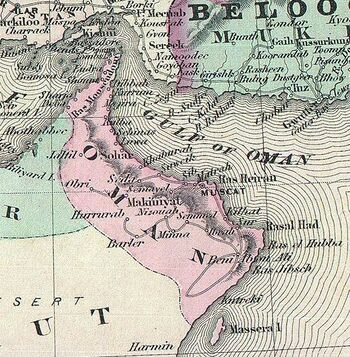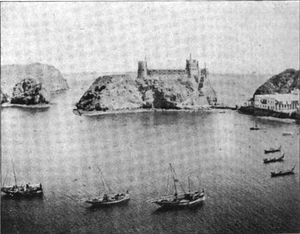سلطنة مسقط
Sultanate of Muscat and Oman سلطنة مسقط وعمان (عربية) | |||||||||
|---|---|---|---|---|---|---|---|---|---|
| 1856–1970 | |||||||||
النشيد: None (until 23 July 1970) From 23 July 1970: نشيد السلام السلطاني "as-Salām as-Sultānī" "Salute to the Sultan" | |||||||||
 The Sultanate of Muscat and Oman in 1867 | |||||||||
| الوضع | De jure sovereign state (1856–1970) De facto British protectorate (1872–1920)[1] | ||||||||
| العاصمة | Muscat | ||||||||
| اللغات الرسمية | Arabic | ||||||||
| اللغات المشتركة | Omani Arabic, Persian, Ottoman Turkish, English | ||||||||
| الدين | Islam (official) | ||||||||
| الحكومة | Absolute monarchy | ||||||||
| Sultan | |||||||||
• 1855–1866 (first) | Thuwaini bin Said | ||||||||
• 1866–1868 | Salim bin Thuwaini | ||||||||
• 1868–1871 | Azzan bin Qais | ||||||||
• 1871–1888 | Turki bin Said | ||||||||
• 1888–1913 | Faisal bin Turki | ||||||||
• 1913–1932 | Taimur bin Faisal | ||||||||
• 1932–1970 | Said bin Taimur | ||||||||
• 1970 (last) | Qaboos bin Said | ||||||||
| التاريخ | |||||||||
• Partition from Zanzibar | 1856 | ||||||||
| 25 September 1920 | |||||||||
| 1954 | |||||||||
| 1962 | |||||||||
• Deposition of Said bin Taimur and Independence from the United Kingdom | 23 July 1970 | ||||||||
• Qaboos declares the Sultanate of Oman | 9 August 1970 | ||||||||
| العملة | Omani dirham (1856–1892) Indian rupee (1892–1959) Gulf rupee (1959–1970) Saidi rial (1970–1972) Omani rial (1972–now) | ||||||||
| |||||||||
| اليوم جزء من | Oman United Arab Emirates Pakistan Iran | ||||||||
سلطنة مسقط، هي امبراطورية بحرية كانت قائمة في القرن الثامن عشر، واتحدت مع إمامة عُمان عام 1820 لتأسيس سلطنة مسقط وعُمان.[2]
غزو نادر شاه لمسقط
عام 1743، استولى نادر شاه على مسقط.[3] عند اغتيال نادر شاه عام 1747 تفككت إمبراطوريته، وهكذا استعادت سلطنة عُمان استقلالها عن الأسرة الأفشارية.
الاستجماع والانحدار
التمرد والتنقيب عن النفط
The discovery of oil in the Persian Gulf exacerbated the dispute between the Sultan in Muscat and the Imams of Oman. Oil exploration had begun in the early 1920s by the Anglo-Persian Oil Company.[4] The course of the Second World War severely disrupted such activities. Further, the Sultanate of Muscat during that time was experiencing terrible social, economic and political conditions. The Sultunate was underdeveloped with no infrastructure or telephones, and Sultan Said bin Taimur prohibited anything that he considered "decadent", including radios.[5][6] The British government continued to have vast political control over the Sultanate as the chief adviser to the Sultan, defense secretary and all ministers of the Sultanate except for one were British.[5] The British government, Iraq Petroleum Company and the Sultan were keen to search for oil and made early plans (1946) to establish an army that could occupy the Imamate of Oman.[7][8]
The last Imam of Oman, Ghalib Bin Ali, started an uprising in 1954 when the Sultan granted licenses to the Iraq Petroleum Company despite the fact that the largest oil fields lay inside the Imamate. The hostilities were put down in 1955, but the longer conflict would evolve into the Jebel Akhdar rebellion, where Sultan Said bin Taimur relied heavily on continued British military support. Iraq Petroleum, along with its operator of oil exploration, Petroleum Development Oman, was owned by European oil giants including Anglo-Iranian Oil's successor British Petroleum which encouraged the British government to extend their support to the Sultan.
The insurgency erupted again in 1957, when Saudi Arabia began supporting the Omani rebels, but eventually the Sultan was able to establish pre-eminence over most of the inland. The same year, British forces bombarded the town of Nizwa, the capital of the Imamate, and toppled the Ibadi theocracy. Ghalib Bin Ali went into exile in Saudi Arabia and the last rebel forces were defeated two years later, in 1959. The Treaty of Seeb was terminated and the autonomous Imamate of Oman abolished.[9]
The frequency of uprisings such as the Dhofar Rebellion, supported by the communist government of South Yemen,[9] motivated the British to supplant the Sultan. The British chose the Western-educated son of the Sultan, Qaboos bin Said who was locked up in the palace, because his father feared a coup. On his release, Qaboos bin Said, with the help of British military forces, staged a successful palace coup and was proclaimed Sultan of Muscat and Oman in 1970. The newly consolidated territories along with Muscat were reorganized into the present-day unified Sultanate of Oman by August 1970.[10]
In 1976, again with British aid, the Sultan secured his hold over the entire interior and suppressed the Dhofar rebellion.
سلطنة صحار
The Sohar Sultanate lasted from 1920 until about 1932. In 1920, Sheik Ali Banu Bu Ali, a relative of Sultan Taimur bin Faisal, rebelled in the northern town of Sohar and proclaimed himself Sultan but was deposed by the British in 1932.
انظر أيضاً
المصادر
- ^ "Oman and the West: State Formation in Oman since 1920" (PDF). Francis Carey Owtram (1999). University of London. Retrieved 31 October 2020.
- ^ Eccles, Captain G. J. (1927). "The Sultanate of Muscat and 'Oman − With a description of a journey into the interior undertaken in 1925". Journal of the Royal Central Asian Society. Vol. 14, no. 1. pp. 19–42. doi:10.1080/03068372708724956.
- ^ Axworthy 2006.
- ^ "Overview". Omani Ministry of Information. Archived from the original on 1 October 2011.
- ^ أ ب خطأ استشهاد: وسم
<ref>غير صحيح؛ لا نص تم توفيره للمراجع المسماةGL - ^ خطأ استشهاد: وسم
<ref>غير صحيح؛ لا نص تم توفيره للمراجع المسماةBNA - ^ The Foreign Office London: File 8/62 Muscat State Affairs: Principal Shaikhs and Tribes of Oman [146r] (291/296).
- ^ Peterson, J. E. (2 January 2013). Oman's Insurgencies: The Sultanate's Struggle for Supremacy. Saqi. ISBN 9780863567025. Retrieved 29 April 2018 – via Google Books.
- ^ أ ب خطأ استشهاد: وسم
<ref>غير صحيح؛ لا نص تم توفيره للمراجع المسماةBackground Note: Oman - ^ "Tribute to His Majesty". Omani Ministry of Information. Archived from the original on 18 January 2006.
المراجع
- Axworthy, Michael (2006). The Sword of Persia: Nader Shah, from Tribal Warrior to Conquering Tyrant. I.B.Tauris. ISBN 978-0857721938.
{{cite book}}: Invalid|ref=harv(help)



